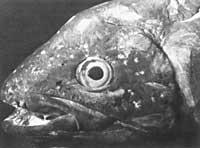Will man do what time has not done?
1995/08/01 Elhuyar Zientzia Iturria: Elhuyar aldizkaria
After the capture of the first specimen by the fishermen of the Comores islands, the celacanthus lives in danger. It is one of the few fossils that survive and, in addition to curious, is the key for vertebrates to understand the moment when they left the sea and headed to the land.

The first news of celacanthus dates back to 1938. It was then that the animal that for centuries has lived in the surroundings of the Comores islands was first seen. Since then, the population of celacantos has been steadily decreasing. According to the latest data, half a dozen no longer arrive. Fishing is the main enemy of these animals. Although the fishermen of the comoros were prohibited from capturing celacanthus, the shortage of other species has led them in recent years.
Environmental organizations have requested special measures to ensure the survival of this beautiful animal. Among them, the most important thing is to create and enforce protection zones. In addition, it has been requested the creation of fishing areas outside the areas where the celacanthus lives, which would face the fishermen. To raise public awareness of the problem, they will install underwater cameras. This will allow to know about the celacanthus.

Gai honi buruzko eduki gehiago
Elhuyarrek garatutako teknologia




